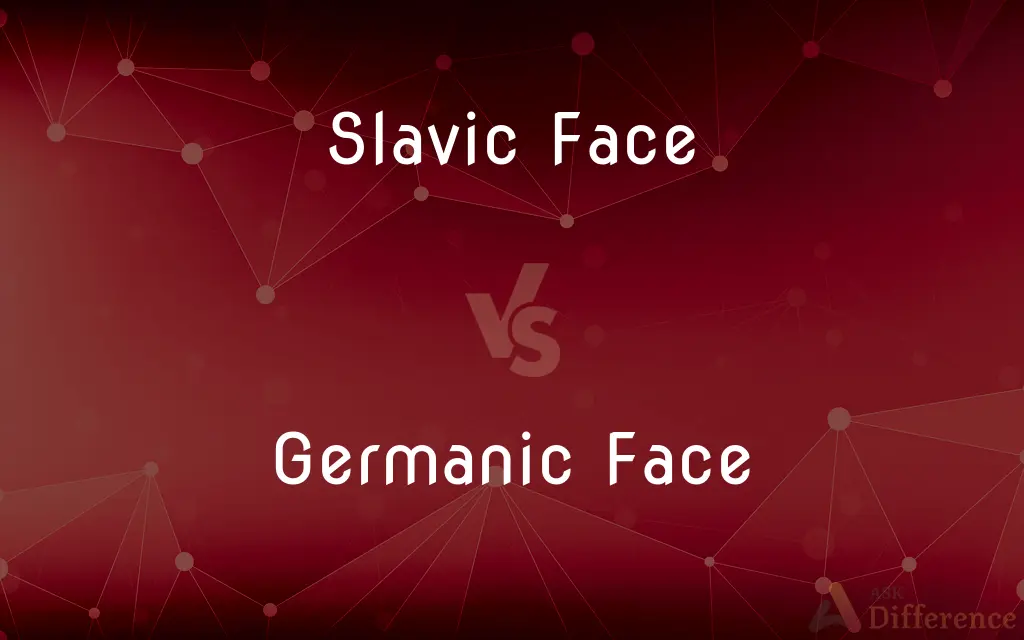Slavic Face vs. Germanic Face — What's the Difference?
By Fiza Rafique — Published on October 27, 2023
“Slavic face” and “Germanic face” are colloquial terms reflecting generalized and stereotypical facial features attributed to Slavic and Germanic ethnic groups, respectively, though individuals within these groups display vast diversity.

Difference Between Slavic Face and Germanic Face
Table of Contents
ADVERTISEMENT
Key Differences
The terms “Slavic face” and “Germanic face” are indicative of supposed typical facial characteristics of the Slavic and Germanic ethnic groups respectively. However, it’s crucial to understand that these are generalized and simplistic classifications, which often don’t hold true due to the extensive diversity within each ethnic group. “Slavic face” is often used to describe people from Slavic nations, which includes countries like Russia, Poland, and Ukraine. In contrast, “Germanic face” usually refers to people from Germanic nations like Germany, Sweden, and England.
The concepts of a “Slavic face” and a “Germanic face” have been formed due to historical, geographical, and cultural contexts. They might include generalized features; for example, Slavic faces are often characterized by high cheekbones and round faces, while Germanic faces might be described as having more angular features and a stronger jawline. These stereotypes, however, are far from universally applicable, as both Slavic and Germanic populations have been subject to centuries of migration, mixing, and cultural exchange, leading to a wide variety of appearances.
It’s also important to approach the terms “Slavic face” and “Germanic face” with caution due to their reductionist nature, potentially perpetuating stereotypes and overlooking individual and sub-group differences. While cultural, genetic, and environmental factors do contribute to physical appearances, the diversity within each group is extensive, making it impractical and misleading to categorize an individual’s appearance as typically Slavic or Germanic based solely on generalized traits.
Attributing generalized characteristics to “Slavic face” and “Germanic face” can lead to assumptions and oversimplifications regarding an individual’s heritage or background. Variations within each group are enormous, reflecting a rich tapestry of histories, migrations, and interactions. It is, therefore, more accurate and respectful to acknowledge the diversity within Slavic and Germanic populations rather than attempting to categorize them based on supposed typical facial features.
Comparison Chart
Generalized Characteristics
High cheekbones, round faces
Angular features, strong jawline
ADVERTISEMENT
Ethnic Groups
Russian, Polish, Ukrainian
German, Swedish, English
Diversity
Extensive due to various sub-groups
Wide, reflecting numerous sub-cultures
Basis
Cultural, geographical and historical contexts
Formed due to historical and cultural influences
Example
People from Russia
Individuals from Germany
Compare with Definitions
Slavic Face
Often characterized by round faces and prominent cheekbones.
The artist’s depiction emphasized the subject's Slavic face.
Germanic Face
Often characterized by angular features and a pronounced jawline.
The sculpture seemed to depict a typical Germanic face with its distinct features.
Slavic Face
Represents a broad categorization based on perceived common facial traits among Slavic people.
The character in the novel was described as having a distinct Slavic face.
Germanic Face
A simplistic representation of the facial characteristics of people from Germanic countries.
The individual’s appearance was quickly labeled as a Germanic face due to certain traits.
Slavic Face
A term reflecting generalized facial features attributed to Slavic ethnic groups.
He thought her high cheekbones suggested a Slavic face.
Germanic Face
A colloquial term used to describe the supposed typical appearance of Germanic individuals.
Her angular features led people to assume she had a Germanic face.
Slavic Face
A simplified representation of facial features of people from Slavic countries.
Observers speculated the portrait represented a Slavic face due to certain facial characteristics.
Germanic Face
A term denoting generalized facial features attributed to Germanic ethnic groups.
His strong jawline was deemed characteristic of a Germanic face.
Slavic Face
A colloquial term used to describe the supposed typical appearance of Slavic individuals.
He was described as having a Slavic face due to his lineage.
Germanic Face
Represents a broad categorization based on perceived common facial traits among Germanic people.
The man’s features were broadly categorized as resembling a Germanic face.
Common Curiosities
Are these terms scientifically defined or more based on cultural perceptions?
While certain regional characteristics can be noted, "Slavic Face" and "Germanic Face" are more cultural generalizations than strict scientific categories.
Is there any historical context to the differentiation between a Slavic and Germanic face?
Historical migrations, invasions, and intermarriages have influenced the physical appearances of both groups, but these categories are mostly based on cultural generalizations.
Are there stereotypes associated with the Slavic and Germanic face?
Yes, cultural stereotypes exist, but it's important to approach them critically and avoid making broad generalizations about individuals based on appearance.
How do factors like environment and genetics play into these facial distinctions?
Both play roles. Genetics define our basic facial structure, while environment, such as diet and climate, can influence aspects like skin texture and tone.
What is meant by "Slavic Face"?
"Slavic Face" refers to the typical facial characteristics and features commonly found in people of Slavic descent, such as those from Russia, Poland, and Ukraine.
How have these facial characteristic perceptions evolved over time?
As the world becomes more globalized and diverse, strict regional facial categories have become more blurred and are seen more as a spectrum than definitive categories.
How does "Germanic Face" differ from "Slavic Face"?
"Germanic Face" refers to facial characteristics commonly found in people of Germanic heritage, like Germans, Dutch, and Scandinavians, which might be different from Slavic features in terms of bone structure, eye shape, and nose form.
Can you identify someone's ancestry based solely on their face?
Not definitively. While some facial features can hint at ancestry, there are always individual variations and overlaps between groups.
Do Slavic and Germanic faces differ in skin tones?
There can be variations, but both groups primarily have fair skin tones, with individual variations ranging from pale to olive.
Is it possible for someone to have features of both a Slavic and Germanic face?
Yes, due to historical migrations and intermixing, it's possible for someone to possess characteristics of both facial types.
Why is it important to approach these terms with caution?
Labeling someone based on facial features can perpetuate stereotypes and overlook the individual's unique identity and experiences.
Is it common for people to mistake a Slavic face for a Germanic face or vice versa?
Given the historical overlaps and migrations between these regions, it's not uncommon for people to mistakenly identify someone's heritage based on facial features alone.
Do other regions have similar generalizations about facial features?
Yes, many regions have cultural perceptions of typical facial features, like "Mediterranean" or "East Asian" faces.
Are there any famous personalities known for having a typical Slavic or Germanic face?
While it's essential to avoid generalizing, some celebrities might be recognized as having features typical of these groups. For example, Gisele Bündchen might be seen as having Germanic features, while Mila Kunis could be seen as having Slavic features.
Can facial features change over generations?
Yes, as populations migrate, intermarry, and adapt to new environments, facial features can evolve over generations.
Share Your Discovery

Previous Comparison
Belgian Malinois vs. Belgian Shepherd
Next Comparison
Looting vs. PillagingAuthor Spotlight
Written by
Fiza RafiqueFiza Rafique is a skilled content writer at AskDifference.com, where she meticulously refines and enhances written pieces. Drawing from her vast editorial expertise, Fiza ensures clarity, accuracy, and precision in every article. Passionate about language, she continually seeks to elevate the quality of content for readers worldwide.














































